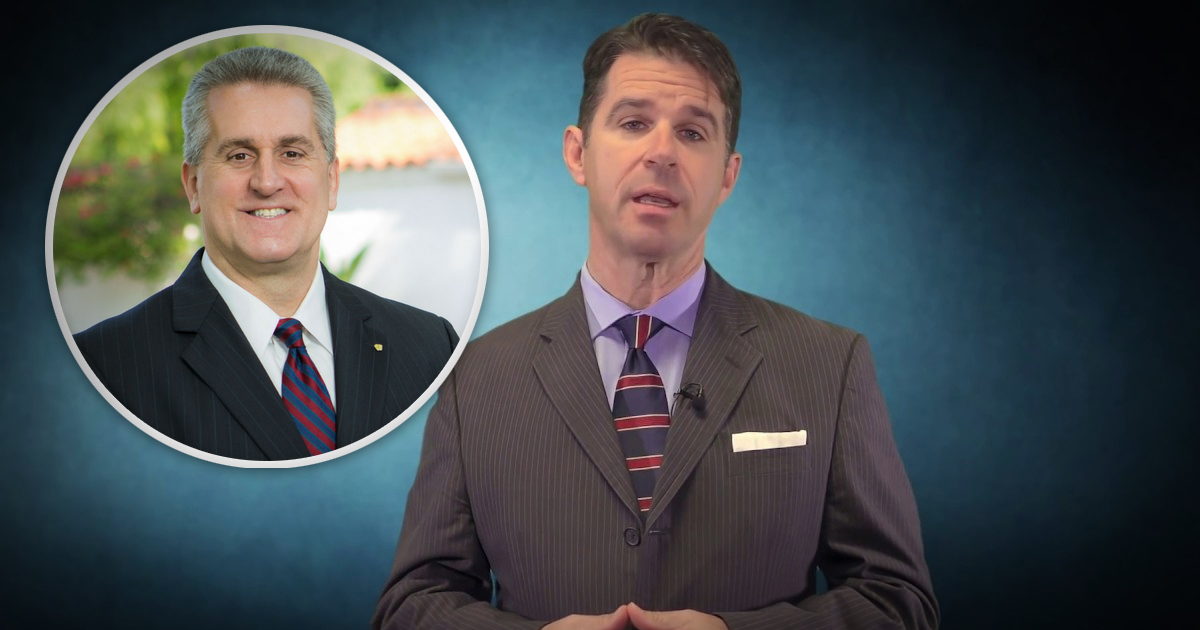Is Jesus a Human Person?
After writing my last post, “When the Word was Made Flesh, Did God Change?” I received an excellent follow-up question. One of my readers still could not get past just how we can say Christ was truly and “fully man,” and yet not be a “human person.” He asked if we could say that somehow Christ could be both a “human person” and a “divine person” in the sense of his “human person” being a “partaker” in the divine person? Would this keep us within the pale of orthodox Catholicism?
The answer is no. You cannot posit a “human person” in Jesus Christ in any sense and avoid heresy. There in only one person in Christ and that person is God!
The Source of the Problem
First of all, I encourage all reading this to also read a previous article of mine called “The Man-God, Jesus Christ” to get a good sense of how we know, from Scripture, that Jesus Christ is both fully God and fully man. That would be a must read for a foundation.
Having said that; however, I had a more specific question here concerning Christ’s person, and it became apparent as I began to respond to it that I really had to define three essential terms in order to get a firm footing to begin the discussion. Apart from these terms being understood, I concluded, we could never resolve the issues at hand.
The first term is “person.” How do we define person as Catholics? The classic definition comes from the great 6th-century philosopher, Boethius, who defined “person” as: “An individual substance of a rational nature.”
But notice, as I did: there is another $64,000 word leaving a $64,000 question within this definition of person: substance. In order to understand what a “person” is, we also have to understand what “substance” means. And I am going to throw in “nature” as well as essential to this intellectual equation for reasons that will become apparent as we proceed. Thus, in order to understand person, we are going to have to understand the definitions of and some of the differences between “person,” “substance,” and “nature.”
As we will see, these terms are very much related, and, unfortunately, sometimes they are used interchangeably, especially in the case of “person” and “substance,” but they are distinct.
The Definitions
We’ve already defined person above as “an individual substance of a rational nature.” But if we don’t know what a “substance” is, we can’t know what this definition means. So what is a “substance,” you ask? Substance in philosophy corresponds to the Greek “ousia” or “being.” It is defined as that which undergirds, grounds, or even better, constitutes an individual thing (whether animate or inanimate, rational or non-rational). It does not inhere in anything else. Thus, it is not a property of a thing, but the thing itself. A property of some thing needs the thing itself for its existence precisely because it inheres in it host. Hair color, or eye color and good examples of “properties” that only exist inasmuch as they inhere in the host hair or eye.
There are millions of examples of substances we could choose from like a “tree,” “horse,” or a “man.” But we’ll consider “man” for our purpose here. What is it that constitutes the “substance” of man? It certainly would not be something like “hair” or “teeth,” for example. A “man” can certainly have no hair or teeth, but still be fully “man.” These two things would be in Aristotle’s category of “property” rather than “substance.”
So, again, the question: What is “substance” and even further, how does that definition apply to “man?”
Well, the “substance” of “man” would be the very foundation of the thing itself we are considering, “man” himself. What is it that is most basic to man without which you do not have a “man” at all? The answer is that “man” is a body/soul composite. Without either a body or a soul, you don’t have the “substance” of a man. You don’t have a man at all in the fullest and substantial sense. Also, remember that “substance” refers to the “subject” itself. In the case of a “rational” substance, it would refer to the “who” of the thing, or the “person.”
Now if we could move briefly back to “person,” the above is why “substance” is so closely related to “person” because “person” refers to the “subject” just as substance does. However, there are crucial differences as well. “Person” and “substance” are different because while all persons are substances, not all substances are persons. A “horse” is a substance, but not a person because, as I said above, a “person” is “an individual substance of a rational nature.” A horse does not possess a rational nature.
Now, when it comes to “nature,” unlike “person” and “substance” we are not speaking of the individual “subject,” or, in the case of rational beings, the “who” of a being, but we are speaking of the “what” of a thing. And like “substance,” “nature” does not necessarily involve a “person” at all. Non-rational, or even non-animate things all possess “natures.” “Nature” refers to the “what” a thing is.
When it comes to man, think of “nature” this way. It is man’s “nature” (or “what”) to be a body/soul composite. Here “nature” and “substance” are almost synonyms, but not quite. Because remember, “substance” always refers to the subject, or, in the case of rational substances, the “who” of a being. But nature does not. It describes “what” a thing is. Or, to help to further understand the differences, “substance” stands in opposition to “accidents” in a given thing. But we can speak of the “nature” of accidents. You can’t speak of the “substance” of accidents because the terms are mutually exclusive. Thus, we see some of the distinctions along with the definitions of our three crucial terms of “person,” “substance,” and “nature.”
The Nuts and Bolts
Now that we have our three definitions, let’s move forward. Consider this: In the case of living human beings, all living human beings are persons. But “person” is not part of the definition of what it means to be fully human. The definition of what a human being is would pertain to the “what” or to the “nature” of a human being. I know that some reading this just had their heresy red flag arise. But slow down a minute and think about this. There is no reason why we could not have a living organism that could be truly human, or, more accurately, could possess a human nature, but not be a human person. There is nothing in the definition of a “human” (being a body/soul composite) that requires it to be a person. Thus, even though this only actually happens in the case of Christ, there is nothing unreasonable about positing the possibility.
I should note one very important addendum to the above. We know the above to be true now, i.e., that all living human beings are also human persons. However, historically speaking, Catholic thinkers once disagreed over when a “human” became a “person.” We now know from the ordinary teaching of the Church that a human being is a person from the moment of conception, but it was not always so in the minds of all Catholics due to the faulty notion of “ensoulment” that was the common scientific understanding of human development from the ancient Greeks until relatively recent in history. Remember: the ovary was not discovered until the 19th century. And it was from this discovery that we would eventually get to the place where we could say we have a human person from the moment of conception. Before that time it was believed by many that the product of human “conception” developed over time into what could be called fully “human” months after conception.
I say all that to say this: It has always been understood that you can have a living “human” without there being a “human person” present necessarily. Thus, it is absolutely reasonable to posit the existence of a human nature in Christ that would not necessarily include a human “person” being present concurrently. However, again, the case where you actually have a living, and fully “human” nature without there being a fully human “person” present only exists in the hypostatic union of Jesus Christ.
Now, I know at this point many questions are arising in many minds. I will try to preempt at least a couple of them. One such question would be, “What is the difference, then, between substance and person? They both seem to pertain to ‘the who’ or the subject being considered?”
I said above that “substance” always refers to the “subject” being discussed and this is true. And the same can be said of “persons.” But remember, all substances are not necessarily persons. Boethius defined person as “an individual substance of a rational nature.” A person must be a rational substance, not just a substance. Thus, as I said above, all persons are substances, but not all substances are necessarily persons. Indeed, angels and men are the only created substances we know of in the universe that are both “substances” and “persons.” But there are millions and millions of substances that are not persons. Mice, bats, dogs, cats… rocks, trees, birds and bees. These and millions more we could list are “substances,” but not persons.
Another question invariably arises here: Are the souls in heaven right now who do not have bodies “substances” or “persons?” The answer is no to both. They are neither fully substances nor are they persons. Once again, heresy red flags are rising, I know! But think about this: The souls in heaven and Purgatory (excluding the Virgin Mary and our Blessed Lord, of course) are not persons because they do not have their bodies. Indeed, according to St. Thomas Aquinas, they are not fully “men” because it is essential to human nature to possess a body (see Summa Theologica, Pt. III, Q. 50). Moreover, because the “substance” of what it means to be “man” includes a body, they cannot be fully human substances either. Some philosophers refer to them as “incomplete substances.”
Now, some would argue human souls are substances because they fit the definition of being a subject that does not inhere in another. And that makes sense. However, the problem comes in when we say they are substances, but not human. That seems to be lacking something as well. The souls in heaven, for example, are human souls. So it would seem odd to say they are not human. Thus, I claim the souls of the faithful departed are “incomplete” substances and not “fully” human” to get at the idea that they are both human and substantial, but they are not fully human nor are they full substances.
But the bottom line here is this: the dead who do not possess bodies are neither substances (fully) nor are they persons.
And by the way, this may well be why texts like Rev. 6:9 and Heb. 12:24 refer to those deceased in Jesus Christ as “souls” and “spirits.” They are not fully “persons” until the resurrection of the body. And just as an added trivia bonus, this is why we Catholics refer to the “souls” of our loved ones in the Church suffering (in Purgatory).
But now to the point: With all of this as a background, perhaps now we can more readily see just how Jesus Christ could reasonably have–and indeed, he is revealed to possess–two “natures,” one human, and one divine (revealing “what” he is), subsisting within one subject, substance, or person (revealing “who” he is). And that one subject or person is God. As I said above, the actual possession of two natures in one person only occurs in Christ. But the point is, this is entirely reasonable.
At the same time, it would not be reasonable to posit; in fact, it would be an oxymoron to say, as well as a heresy from a Catholic perspective, one person (subject, or substance) could be one person (subject, or substance) and two persons (subjects, or substances) at the same time. That would be akin to positing square circles. It violates the principle of non-contradiction. A thing cannot be and not be with regard to the same perfection at the same time.
Added Bonus
If we do not have a proper understanding of the hypostatic union of Christ with regard to his two natures and one person, other teachings of the Church will become incoherent as well. Here is just one example. In the Catechism of the Catholic Church, paragraphs 626-627, we discover the traditional teaching of the Church that tells us that when Christ died, his human flesh was separated from his human soul, so he really did die, but unlike other humans, his body and soul were never separated from his person.
Sounds odd, eh?
Think about this: When other men die, i.e. the rest of us, their persons cease to exist along with their bodies. Why? Because it is constitutive of a human person (or substance, or nature) to possess a body. Without a body, you don’t have either a human nature, or a human person. So when the human body is substantially changed into a corpse at death, you no longer have either a human body or a human person. But because Christ’s human nature had and has a divine person as its subject, both the human body and human soul of Christ remained in union with the second person of the Blessed Trinity even in death. The divine person of Christ cannot suffer the “change” involved in death, like other humans, even though he did, in fact, experience death as subject of Christ’s human nature. The Catechism of the Catholic Church puts it like this:
Since the “Author of life” who was killed is the same “living one [who has] risen”, the divine person of the Son of God necessarily continued to possess his human soul and body, separated from each other by death:
“By the fact that at Christ’s death his soul was separated from his flesh, his one person is not itself divided into two persons; for the human body and soul of Christ have existed in the same way from the beginning of his earthly existence, in the divine person of the Word; and in death, although separated from each other, both remained with one and the same person of the Word” (Quoting: St. John Damascene, De fide orth. 3, 27).
Christ’s death was a real death in that it put an end to his earthly human existence. But because of the union which the person of the Son retained with his body, his was not a mortal corpse like others, for “it was not possible for death to hold him” and therefore “divine power preserved Christ’s body from corruption.” Both of these statements can be said of Christ: “He was cut off out of the land of the living”, and “My flesh will dwell in hope. For you will not abandon my soul to Hades, nor let your Holy One see corruption.” Jesus’ Resurrection “on the third day” was the sign of this, also because bodily decay was held to begin on the fourth day after death.
In a nutshell, there can be no separation of the person of Christ from his body and soul, only a separation between Christ’s body and soul, which is the essence of what death is. For the rest of we humans, our “person” ceases to exist when we die and is resurrected along with our bodies at the end of time. Our souls alone continue in Heaven, Hell, or Purgatory. But there can be no death or resurrection of the “person” of Christ because his “person” can never die, in the sense of suffering the inherit “change” that comes from death in us! Christ’s person is Second Person of the Blessed Trinity!
Conclusion
It is easy to fall prey to false suppositions that can lead to heresy when we speak of our Christology. It seems logical to say, “Because Christ is fully human, he had to be a human person.” But the truth is, the former is correct, but the latter is a non-sequitur. When we understand the truth of what “human nature” is, we have no problem in saying Christ is “fully human,” but not a “human person.” Why? Because a fully human nature consists of a rational “body/soul composite.” That is “what” a human nature is before we ever consider the “who” or “person” of a particular human. Thus, Christ certainly could possess two natures that define “what” he is, both human and divine, while subsisting within his one person or subject.
To employ our term, “substance,” here, we would say Christ is not, and indeed, could not be two substances any more than he could be two persons without creating two beings and all kind of trouble by way of heresies! Moreover, once we go down the road of “two persons” or “two substances” we would no longer be speaking of a “he” any longer. We would then have to start talking about “them!” And if there is one thing clear in Scripture, Jesus is never revealed to be a “them.” “He” is a “he” (see Colossians 1:15-22).
But two natures are no problem because nature does not pertain to the “who” (person). It only pertains to the “what” (nature). To say Christ has two natures does not say he is two subjects. It simply says he is both human and divine via his two natures. “He” is still a “he;” the one Divine Person of Jesus Christ.





